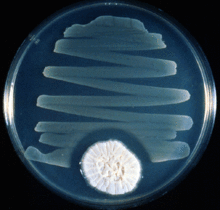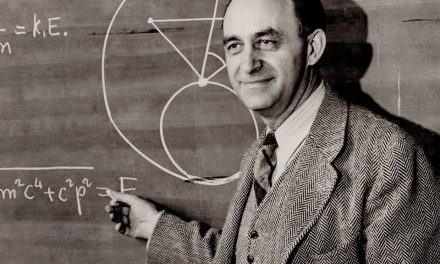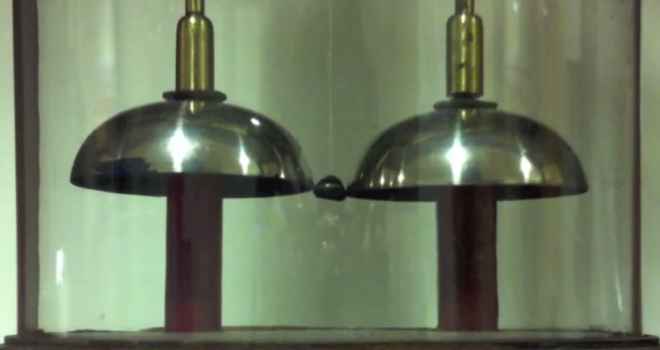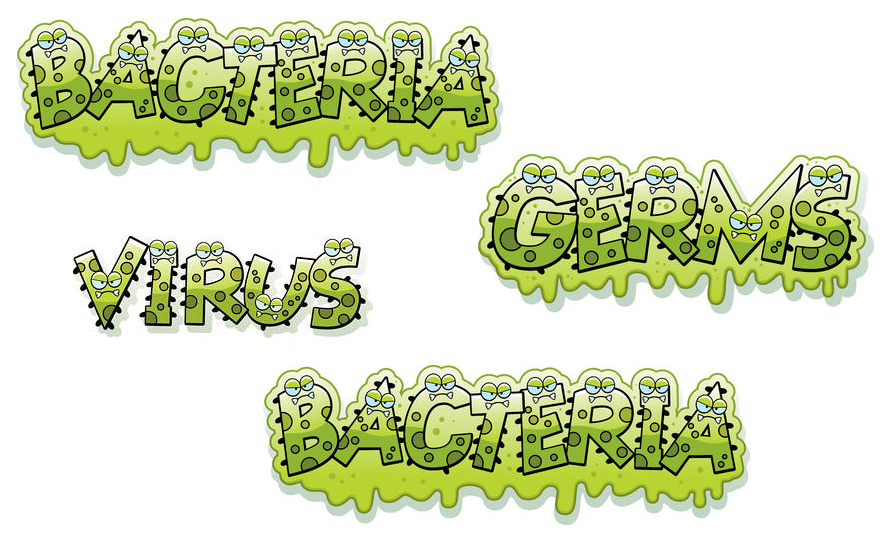
Penicillin
To understand the story of penicillin, we must forget that we know what penicillin can do. We must go back to a small crowded laboratory in a London hospital, in 1928.
Dr Alexander Fleming was doing some research on bacteria. He was studying the staphylococcus bacteria, which cause many unpleasant and often dangerous infections. Examples of the bacteria were being grown by Fleming in small, glass culture dishes. Every now and then he would remove the lid from a dish and examine the bacteria under a microscope. One day Fleming came back from holiday and threw away some old culture dishes which had become spoilt by contamination. By chance an assistant came into his room, and Dr Fleming picked up several dishes to show him what a contaminated plate looked like. Then Fleming noticed a mould growing on the top edge of one of the dishes. It looked rather like the mould on cheese or bread.
When he was old and famous, Fleming always talked about the importance of chance in his life. ‘ I have been wonderfully lucky, you know’ he would tell students. Luck gave him a second look at something he had already thrown away. Fleming’s trained eye noticed that the bacteria next to the patch of mould were shrivelling up, dissolving. ‘What had formerly been a well-developed staphylococcus colony was now but a shadow of its former self’ he wrote.
What did this mean? Something made by the mould was destroying one of the powerful bacteria which attack man. Fleming decided to call this something penicillin, because it came from one of the penicillium moulds. That was the really big piece of luck. There are thousands of different moulds which could – and sometimes did – drift on to a culture dish and start growing. There are more than six hundred and fifty different penicillium moulds, but very few make penicillin. ‘That same mould might have dropped on many of my culture plates and there would have been no visible change to direct special attention to it. It might even have dropped on that same culture plate at a different stage of growth and shown nothing. However, somehow or other, everything fitted in and there was an appearance which called for investigation’. All the same Fleming said,’I had not the slightest suspicion that I was at the beginning of something extraordinary’.
Very carefully Fleming drew a speck of the interesting mould off the dish and put it in some nice warm broth where it could grow. After a few days he strained the broth to remove the mould, and began to investigate the liquid left behind – called mould juice by Fleming – which contained the mysterious penicillin. He found that it destroyed some bacteria, but did not affect others. He injected some of the mould juice into a healthy rabbit, then a mouse, to see if it was poisonous. It wasn’t. Fleming’s friends remember him asking if they had any old mouldy shoes lying around. If they had, he would take a little mould out of the damp, dark inside of the shoe and test it in the same way. He had to see if any other moulds had a similar effect on bacteria as his penicillin. They didn’t.
Not many people took any notice of Alexander Fleming’s discovery. Doctors and researchers had always been hoping to find something that would fight bacteria in the body – an antibiotic – without hurting the body itself, rather like a sort of magic bullet. Dr Fleming’s penicillin did not seem harmful to the body cells. But Fleming was not able to find out what the mould juice really was, or how to keep it, or how to get the penicillin out of it. Nor were other researchers who tried in subsequent years. Mould juice by itself was no use to medicine.
Ten years after Fleming’s discovery, a group of researchers at the University of Oxford decided to investigate thoroughly those naturally-occurring substances that attack bacteria. In 1939 they began to study penicillin in detail, even though it was thought to be too unstable to spend much time on. No one was really thinking about possible medical benefits. It was a programme of research to find out answers to important problems. What was this penicillin ? The head of the department, Dr Howard Florey (later Lord Florey), gathered together a team of specialists. Some of Fleming’s original penicillin mould happened to be stored in a nearby laboratory.
Gradually the chemists in the team discovered ways to purify the mould juice and extract the penicillin from it. Penicillin was most unstable and difficult. ‘It vanishes almost while you look at it,’ they complained. The Oxford workers used new techniques which had been developed since Fleming tried, and developed more of their own. After eight months’ hard work they had enough penicillin to make some crucial tests. They took healthy mice and infected them with bacteria. They injected some of the infected mice with penicillin and these lived, while the others not given penicillin died. The experiments proved that penicillin was truly less harmful to an animal’s body than to the bacteria invading it. The crude powder used would prevent germs from multiplying even when diluted one in a million times. Later it was found that the powder used in these mouse experiments was so impure it contained less than two per cent of penicillin – yet it was successful. Old Dr Fleming read the results of the mice experiments and caught a train up to Oxford to see the precious penicillin. Dr Ernst Chain, one of the researchers, was amazed. He didn’t know Fleming was still alive!
Penicillin must now be tried on human patients. Could it be a true antibiotic, something which would successfully fight harmful bacteria in the human body ? A man is, of course, three thousand times the size of a mouse. Florey knew that much more penicillin would be needed. It was wartime. Britain was being bombed. The researchers rubbed spores of the mould on the insides of their pockets so that if a bomb fell, and one of the team escaped, the same strain of mould would be saved to be worked on elsewhere. Florey asked British chemical firms to help produce the necessary penicillin, but with the war raging no one could do it. The only thing left was to try to find ways of growing sufficient penicillin in the laboratory.
There weren’t nearly enough containers. The mould was grown in biscuit tins, trays, pie-dishes, even in sixteen old-fashioned enamel bedpans. Laboratory assistants filled the containers with culture liquid and sowed it with spores of the mould. First a fine white hairy mould would appear on the surface of the culture liquid. Then it would turn bluish-green and become thick and wrinkled. After about a week the liquid under the mould would be yellow. Now the liquid had to be carefully removed and new fluid put in for the mould to feed off and grow more penicillin. It was a dreadfully tricky, uncomfortable, slow job. One germ could spoil the lot. But all this was simple compared to the actual extraction of penicillin from the crude mould juice. After purifying, each container of liquid would yield a tiny quantity of die fine brownish-yellow powder that was penicillin. The work went on for eight months before there was enough penicillin stored in the refrigerator to treat a human being.
In an Oxford hospital a policeman was dying of an acute infection. Nothing available could help him. The penicillin wastried and it worked, for five days. The policeman began to get better. ‘I remember very clearly still/ one of the team said, ‘bicycling over to the laboratory in the evening, carrying the man’s urine and the news of how he was doing. And Chain dancing with excitement at the possibility of a real triumph inmedicine,and Florey reserved and quiet, but nonetheless intensely thrilled’. Sadly, the precious powder ran out before the man was completely cured, the bacteria took over again in his body, and he died.
Next the doctors in the team were able to treat four children. Penicillin proved effective. ‘This,’ said one of the doctors was the most dramatic experience to witness: the birth of a drug. Five or six patients weren’t much evidence to go on. But penicillin had proved that it was important in treating certain infections, and there was every chance that it would be valuable in treating war wounds. It was vital that large supplies should now be made available.
Howard Florey decided to go to the United States to try to persuade drug firms there to mass-produce penicillin. The laboratory methods worked out at Oxford were too slow and time-consuming, and the yield of penicillin from them was pitifully small. Ten to twenty gallons of mould juice was needed to treat a simple infection. Entirely new techniques had to be found, but this meant solving enormous new problems. Florey managed to persuade enough people in America to give the problems high priority. Several firms cooperated with researchers and the United States government, and the Oxford team handed over all the results of their work. Research and development did in fact cost millions and millions of dollars.
Yet even now, chance kept coming into the penicillin story. Researchers at Peoria, Illinois, had the job of getting the mould to produce more penicillin. They started hunting for a better strain of penicillin mould. All the penicillin so far made was descended from the original spore which landed on Alexander Fleming’s work-bench back in 1928. Air-force men were asked to send samples of mould from all round the world to the laboratory at Peoria. None was any good. A laboratory assistant nicknamed Mouldy Mary had the job of going to the local market every day and bringing back all the mouldy fruit and vegetables she could find. One day she brought back a mouldy melon. Here was the energetic mould for which they had searched all over the world, Much of the penicillin used today is descended from that mouldy melon.
By 1943 penicillin was becoming available for wounded soldiers. ‘It was really on the invasion of Italy and Sicily when the drug went in almost with the bullet on the beaches that the most dramatic results were seen. Florey had the great excitement of waiting in North Africa and seeing the wounded men arrive with their wounds in a state never seen in history before. This meant not only the saving of life, but saving of limbs, saving pain.’
The public heard of penicillin. There was intense excitement. Here was a miracle drug. The yellow wonder powder! ‘I have never said that penicillin can cure everything? wrote Alexander Fleming. ‘It is the newspapers that have said that. It does have an extraordinary effect in certain cases of illness, but none in others …’ But people did not want to listen. They wanted to believe disease could now be defeated. Romantic, exaggerated stories were told about the discovery of penicillin. Fleming used to keep a cuttings book of all the untrue stories about him. Honours were heaped on the discoverers. Fleming and Florey were knighted. Fleming, Florey and Chain shared the Nobel Prize for Medicine in 1945.
Penicillin has saved hundreds of thousands of lives, and will go on doing so. We have probably all been treated with it, sometimes for quite minor things. Today it is one of many antibiotics available, and research goes on all the time for new ones. All the work at Oxford from 1939 to 1941 – the treatment of patients, the chemical, biological and bacteriological studies – was done with about four million units of hard-won penicillin. More than four million units can be given as a single dose these days. Penicillin is now truly everyday.






You must be logged in to post a comment.